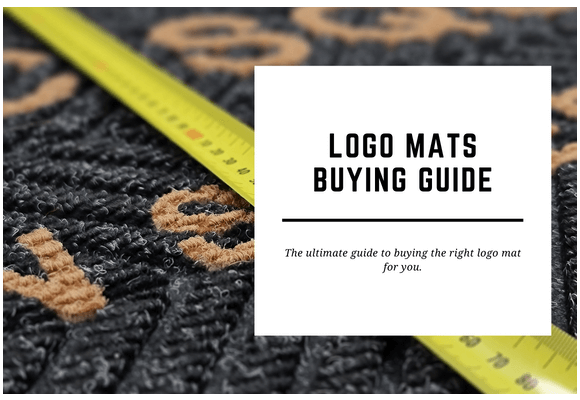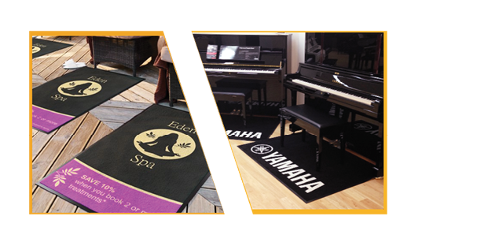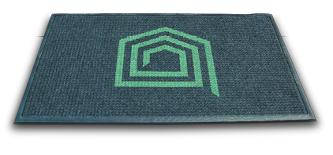
Logo Mats Buying Guide
In this guide
1| Choosing by design
1.1 Sublimination Imprint
1.2 InkJet
1.3 Inlay
1.4 Flocking
2| Choosing a material
2.1 Rubber
2.2 Carpet Surface
2.3 Coir
3| Sizing
3.1 Standard sizing
3.2 Custom sizing
4| Traffic Level
4.1 High
4.2 Medium
4.3 Low
5| Maintainance
1| Choosing by design
The biggest factor in choosing your logo mat is the type of design you want. If you want a really intricate design in a lot of different colours, you may have to compromise on the structural quality of the mat.
1.1 Sublimination Imprint
Sublimation allows us to print really intricate designs onto a really low-profile mat. Full-colour photo mats work best with this method. Sublimination imprint also allows us to include as many colours as you want from an infinite palette of colour matches.
The downside of using sublimation is that it can only be done on mats that don’t last as long as other methods. The mats need to be thinner to print the designs, so sublimation won’t work well in high-traffic environments.
We recommend sublimation imprint for:
- Brand activations
- One-off events
- Gifts
- Low traffic applications
- Loose-laid entrance mats with low traffic level
1.2 InkJet
InkJet is our most popular printing method for logo mats. It allows us to clearly print designs with lines from 3mm thickness and PMS colour match to ensure your logo mat is 100% on-brand.
The downfall of InkJet is that anything less than 3mm begins to look less clear. So, we can’t print really intricate designs or photos. This is because the nylon fibres move around somewhat as they are walked over, which can cause the image to look blurry.
We recommend InkJet for:
- Branded logo entrance mats
- Functional logo mats (preventing slips, keeping floors clean)
- Medium to high traffic applications
1.3 Inlay
The inlay printing method produces the toughest, most durable custom mats. It is the only printing method that can personalise coir matting, which makes a logo mat that is better for wet areas, as it will not absorb as much water as a nylon logo mat.
The main disadvantage of the Inlay method is that it cannot produce a detailed design. The minimum line width for a clear design is 8mm, due to the amount that coir fibres are crushed underfoot.
We recommend the inlay method for:
- Coir logo mats
- Very high traffic applications
1.4 Flocking
Flocking is a mat printing method that uses a screen and template to print adhesive onto a mat. Electrically charged strains of carpet can then be dropped into the adhesive, where they stand up straight and stick in the desired shape.
The main benefit of flocking is its endurance – a flocked logo mat will last forever! It also has a luxurious, velvety feel. The main drawback is that the design is limited. As it is coloured by hand, it isn’t possible to create gradients or shading.
We do not currently offer any products made using flocking.
2| Choosing a material
2.1 Rubber
Rubber is ideal for wet areas. It offers natural slip resistance and won’t absorb or hold water. It is our most popular material for industrial and hospitality applications.
We offer logo mats in natural or synthetic recycled rubber. Natural rubber tends to perform best, while synthetic rubber is generally more consistent and has more of a smell to it.
2.2 Carpet surface
You can also choose to utilise the non-slip abilities of rubber without going for a full rubber mat. Rubber-backed mats can have a carpeted surface, which is perfect for drying shoes and preventing your floors from becoming a slip hazard.
Our range of carpet surfaced logo mats include durable nylon twist pile and loop pile made from PVC. Many of our nylon mats are made by ECONYL, a brilliant company that recycles abandoned fishing nets and other garbage into virgin-quality nylon.
2.3 Coir
Coir is one of our most popular matting materials. It is a durable and eco-friendly option that scrapes shoes very efficiently. Coir is made from the husk of coconut shells, which is a by-product of the industry after the fruits and shells are harvested.
Coir is perfect for inside and outside undercover and can also be used in wet areas. For outside or wet areas, do not choose a coir mat with rubber backing. Rubber does not expand as coir does, so a wet mat made from both materials will quickly become misshapen.
3| Sizing
Depending on your application, you can choose between a range of standard sizes. If there are no custom sizes to suit your needs, we also offer custom-sized options and entire floor fittings.
Get in touch with your measurements for a custom quote or reach out to one of the team to ask about a measuring service.
3.1 Standard sizing
Standard sizes are as below:
|
• 45 x 75cm • 60 x 85cm • 60 x 90cm • 60 x 175cm • 75 x 90cm • 90 x 90cm • 85 x 120cm • 85 x 140cm • 90 x 120cm |
• 85 x 150cm • 90 x 150cm • 90 x 300cm • 120 x 180cm • 85 x 300cm • 115 x 300cm • 115 x 180cm • 115 x 240cm • 175 x 300cm |
3.2 Custom sizing
Custom size logo mats with a carpeted surface are available in any size between 500x500mm and 8000x1800mm.
4| Traffic Level
Logo mats need to do more than just look great.
As with any mat, you need to consider the level of foot traffic you expect to pass over your mat. Busier areas require durable mats that will offer sturdy slip protection as well as showcase your brand.
4.1 High
For high-traffic areas, we recommend a sturdy non slip logo mat that either has rubber backing or is fitted into a mat recess. Inlay or InkJet methods are best for these.
4.2 Medium
For medium-traffic areas, you need to prioritise. If a crisp, detailed image is most important for your logo mat, you may want to forego the safety and cleaning properties of higher-quality mats.
4.3 Low
If traffic levels are low in your space, you can go for the logo mats with the highest level of detail, such as sublimation.
Remember that these mats will not last as long as others.
5| Maintenance
Cleaning your logo mat is straightforward, but the best technique depends on which material you go for. Rubber logo mats have a smooth surface that can be cleaned with a quick wipe or mop, whereas carpet surfaced mats are best cleaned with a vacuum.
Coir mats should be firmly shaken and brushed to remove dirt. The only machine washable logo mats are the nylon twist pile mats.
6| Additional features
As well as displaying your logo loud and proud, you might need your customised mat to have other features too.
6.1 Non slip backing
Any mat that will be loose laid on the floor needs to have non slip backing. This is particularly important if you have high or medium traffic levels, or are responsible for children, older adults or the general public.
6.2 Bevelled edges
Bevelled edges are ideal if you need wheeled traffic to pass over your logo mat. Bevelled edges are slightly ramped to allow a smooth transition on and off the mat, reducing the chance of a trip accident.
Even if you only expect foot traffic to use your logo mat, bevelled edges make it safer.
6.3 Absorbency
Inside logo mats placed in a wet climate need to absorb water from shoes. Likewise, areas that see a small amount of water spillage can benefit from absorbent surfaces. Please note that absorbent mats are not suitable for very wet areas.
7| Product recommendations
To help you choose the best logo mat for your application, here are some general recommendations. For a personalised recommendation, custom-sized logo mat quotes or information about any of our products, get in touch with the team.
7.1 Commercial Buildings
Commercial kitchens need something easy to clean that will absorb water without being ruined by it. You will also need something that won’t cause additional safety hazards, so a non slip backing is crucial.
For commercial kitchens prone to water spillage, the best option is:
Durable Nylon Twist Pile Welcome Mat with Rubber Backing Black Mat With Grey Text 85 x 150cm
7.2 Outside areas
For your home or office, a synthetic coir mat can give you all the benefits of the natural one without the maintenance. Our synthetic coir mats come in natural colour to look like the real deal or dyed black or grey.
For homes and offices, the best option is:
Hardwearing Poly Propylene Synthetic Coir Entrance Mat Natural
7.3 Warehouses and Factories
Warehouses and factory floors need a logo mat that will hold its message or design while also prioritising safety. They definitely need a non slip backing, but also need to scrape shoes effectively to keep floors clean and safe.
For warehouses and factories, the best option is:
Durable Nylon Twist Pile Welcome Mat with Rubber Backing Black Mat With Grey Text 85 x 150cm
8| Ordering process
Hopefully, this guide has helped you decide which door mats suit your needs. To get your order started, contact the team directly or order online.
- Phone: 1300 628 746
- Email: [email protected]
- Online: https://www.matshop.com.au/door-mats



